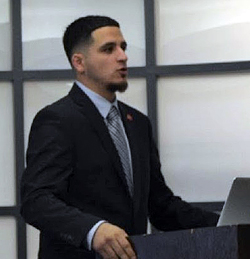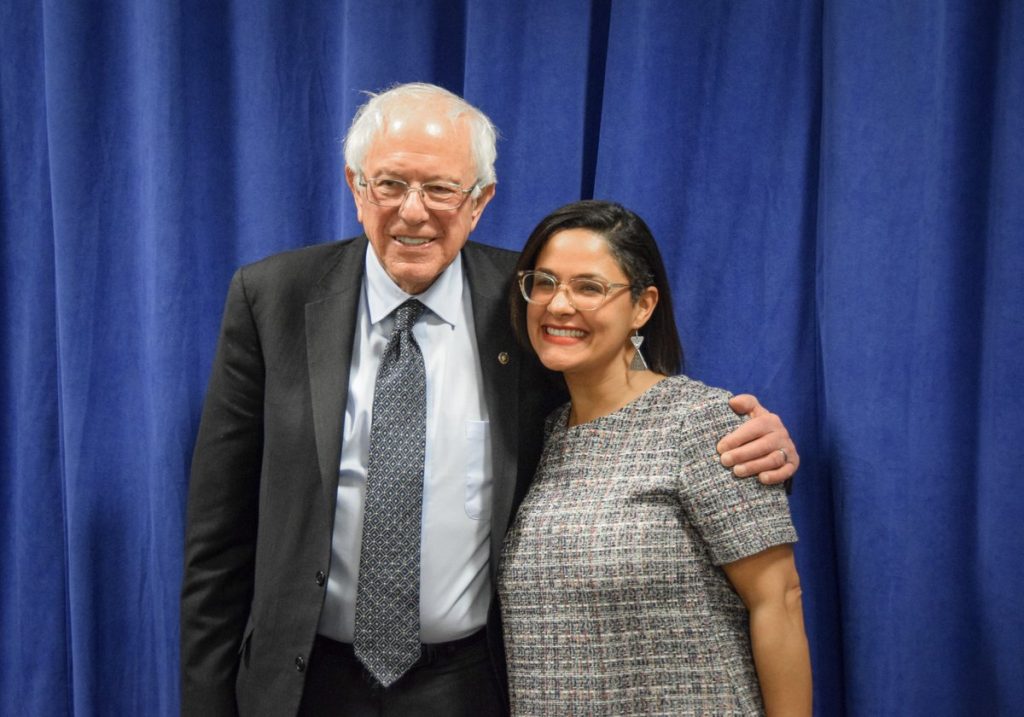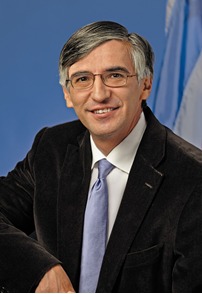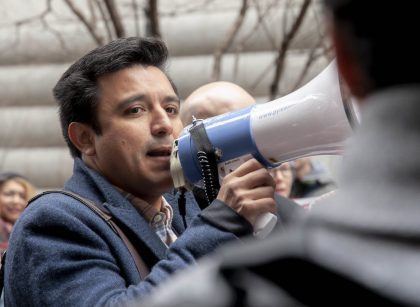
Chicago’s sharpest demographer can’t stop won’t stop. José Miguel Acosta-Córdova talks so fast and knows so much that a reporter calling him for comment literally cannot keep up.
Acosta-Córdova was the author of the Latino Neighborhoods Report: Issues and Prospects for Chicago, which he wrote as a grad student at UIC while working as a Research Assistant at the Institute for Research on Race and Public Policy (IRRPP). during his second year of graduate school. The report compiled the most complete demographic information ever assembled on twelve Latino neighborhoods and painted an authoritative portrait of Hispanic life in Chicago.
Acosta-Córdova’s report was published in October 2017, just two weeks after the US census released data showing that the Hispanic population surpassed all other minorities in the Chicago area. For the first time, Latinos had become the second largest racial and ethnic group in Chicago – ahead African-Americans and just behind whites.
For a few weeks, Acosta-Córdova seemed to be everywhere. He appeared on television and radio and at press conferences as pundits assessed what these changes would mean for all three ethnic groups, and for Chicago generally.
Two years later, as the country gears up for one of the most eagerly anticipated and controversial census periods in history, Chicago Mundo Hoy decided to check in with Acosta-Córdova to see if things have played out as expected.
Acosta-Córdova is currently the environmental planning and research organizer at the at Little Village Environmental Justice Organization, where he is following in his parents’ footsteps as an activist working on local issues of environmental justice. With his report having been the rare academic document that somehow filters into popular consciousness, Chicago Mundo Hoy asked Acosta-Córdova how the release of the report changed his life. He said, “After the report was released, there were several city councilmen who wanted to pit black vs brown over resource allocation.”
Growing numbers of Hispanics is translating into growing numbers of Hispanics in power
Acosta-Córdova said that the strengthening of Hispanic numbers is being reflected in elected officials throughout the city and sate.
“Look at Rossana Rodríguez and Andre Vasquez on the Northwest side!” referring to two Latino pols who ousted white incumbents in run-off elections this spring. Democratic Socialist Rossana Rodríguez Sanchez defeated incumbent Deb Mell by 13 votes in 2019 to become alderwoman of the 33rd ward, which ended a 44-year reign of a Mell running the 33rd ward, which her father Richard Mell had held since 1975. Andre Vasquez is the rapper and Democratic Socialist who defeated incumbent Patrick O’Connor in a run-off to become alderman of the 40th ward.

Some of the findings of the Acosta-Córdova report noted how specific neighborhoods had witnessed giant growth in Hispanic population.
Places like Belmont Cragin (with 63,377 Hispanics), La Villita (62,928), and Gage Park (38,009) were contributing huge numbers to Chicago’s 803,000 total Hispanic residents. “Pilsen hasn’t ever been the largest Latino neighborhood,” Acosta-Córdova told Chicago Mundo Hoy. “Belmont Cragin is largest in total. But what’s fascinating to look at now is the way new neighborhoods are starting to trend. Portage Park at 47% is on the verge of becoming majority Latino. Jefferson Park is at 20-something percent.”
Acosta-Córdova also pointed to the 14th Ward, where the longest-serving alderman in Chicago history Ed Burke has held sway as a perennial on lists of “100 most powerful Chicagoans.” Burke is of course facing federal charges of attempted extortion, but that’s almost beside the point for the young demographer. “Ed Burke is in a ward that’s 80% Latino. That transformation never really translated politically. The bungalow belt – Mayor Daley’s core constituency – is becoming more and more Hispanic. The old machine is kind of dying and on its last breath. Look at the state rep race on the southwest side, where Ortíz beat Ed Burke’s brother.”
He’s referring to Aarón M. Ortíz (D-1), the high school teacher who defeated Daniel J. Burke in the 2018 Democratic primary running on a slate of Latino candidates backed by Jesús G. “Chuy” García, who was then a Cook County Commissioner and is now a Congressman.
“Chuy Garcia has been pushing to get more representation on the Southwest side. That explains the rise of Commissioner Alma E. Anaya (who replaced Chuy on county commission) and others.”
Acosta-Córdova understands the arguments in favor of allowing long-serving pols to exercise the power they’ve accumulated. “Yes, Burke is very powerful. You can make the case that he’s done a lot for his ward. But has that helped his constituents and the brown people in the area? It’s right by the canal and when you look at environmental justice… Not a lot of people who live next to these industries actually work in these industries. The semi-trucks pass through and the particulate matter gets emitted. Ed Burke has done a lot to allow industries to thrive in his ward. But has that really helped or hurt the people who live in that ward?”
A controversy over the Crawford Power Station
Little Village provides a good example. According to Acosta-Córdova, fewer than 5% of those working in the Little Village Industrial Corridor Little Village residents actually live in Little Village. In fact, 60% of those who work there don’t even live in the city – they aren’t paying taxes in Chicago. Similarly, 1252.2 acres dedicated to industry take up 44% of South Lawndale but only a small handful of the neighborhood works there. Yet, the entire neighborhood is dealing with the metal shredders and concrete mixers, not to mention the trucking and pollution.”
According to Acosta-Córdova, it’s not enough to have a representative who resembles those he or she represents. “Even if you have a Latino alderman, if he gets bought off by the industry, who does he really represent?”
He tells the story of the Crawford Power Station at 35th and Pulaski – the two gigantic coal-fired power plants that were considered engineering – and even architectural — marvels when built in 1903 and 1926.
“We fought for years to shut it down and Rahm Emanuel was on board to transition from fossil fuel to renewable. In 2012. Then in recent years HilCo gave Rahm almost $120,000 over 8 years and donated to alderman Muñoz before he retired.”

The plan Hilco is putting forward now is to knock down the plant and remediate the site and build a 1 million square foot ecommerce warehouse. That would be largest in the city limits and Hilco claims it will bring 360 construction and project jobs and 178 permanent jobs.
But according to Acosta-Córdova, it will also “bring hundreds more semi trucks to the neighborhood. The entire community was against it. HilCo had two meetings and everyone was against it, full of people saying we’d rather have an empty coal plant as a lasting symbol of our resistance. Little Village already has the 2nd worst air quality in Illinois.”
Nevertheless, the plan still got the thumbs up from the council.
“They still approved the warehouse – it got forced through but we’re still fighting it. We’re slowing them down, they’re six months behind. Ultimately, the process was a joke. The community was totally united against it; but the alderman and local chamber of commerce supported it. It went to Plan Commission, which at time was a rubber stamp for Rahm Emanuel. The very next week it went to the City Council and we reached out to a lot of them. We got the support of Carlos Ramirez-Rosa (Ward 35) and Milly Santiago [the former television reporter who became the 31st ward Alderwoman but narrowly lost her 2019 re-election bid to Felix Cardona]. But then Muñoz used aldermanic prerogative to say ‘All your objections mean nothing.’ He pushed it through and they’ve started the remediation process.”
Acosta-Córdova is referring to then-Alderman Ricardo Muñoz, the Mexican-born politician who represented the 22nd ward, which includes Little Village. This shows how incredibly complicated things can grow. Muñoz was appointed to the City Council in 1993 by Mayor Richard M. Daley to replace Muñoz’s mentor – you guessed it, Chuy García, who had joined the Illinois Senate. Muñoz worked for García for years, eventually becoming chief of staff. And the City Council is where Muñoz sat until 2019, when he decided not to run for re-election following a misdemeanor arrest after he was charged with assaulting his wife on New Year’s Eve.
- Cannabis Chief’s Abrupt Firing Leads to Speculation - August 26, 2020
- As Latino population surges, José Miguel Acosta-Córdova takes stock - November 22, 2019



